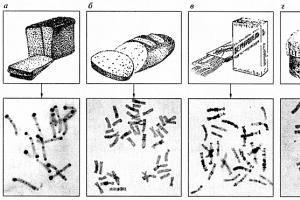Almost every man has a set of tools in his home or garage. Therefore, it is worth keeping them in perfect order. A new review will tell you how best to do this. Surely everyone will be able to find in it examples of organizing storage space that interest him.
1. Plastic cans

Trimmed canisters are perfect for storing nails, screws, bolts and nuts. And in order not to dig around for a long time in search of what you need, it is better to label the containers.
2. Wooden shelf

Narrow wooden shelf with holes - a great place to store screwdrivers.
3. Stand

To prevent pliers from being scattered throughout the garage, make a special one for them. wooden stand.
4. Railing

A thin metal rod is perfect for storage paint brushes in limbo.
5. Individual cells

From the leftovers PVC pipes You can make convenient cells for careful storage of small power tools.
6. Wooden shelving

DIY Wooden Storage Rack wrenches will allow you to forget forever about the mess and tedious search for the right tool.
7. Open locker

An open wooden cabinet is perfect would be better suited for storage aerosol paints, which are most often randomly scattered in the garage.
8. Mobile stand

A small stand on wheels is perfect for storage hand tools. This rack is very compact and will always allow you to have the right tool at hand.
9. Wooden stand

A stylish wooden stand with a shelf, which is suitable for storing many of the most different instruments. Such a product will not only help organize hand tools, but will also become a real decoration for a man’s monastery.
10. Homemade stand

An unnecessary pallet can be turned into convenient stand for storing garden tools, which often take up a lot of space in the garage.
11. Hanger

Simple wooden block with metal hooks will forever solve the problem of storing power tools.
12. Clothes hangers

Simple manipulations with an ordinary clothes hanger will turn it into convenient organizer for storing electrical tape and adhesive tape.
13. Storage system

Forks, shovels, rakes, etc. garden tools not very stable and also takes up a lot of space in the garage. Reliable wooden hooks on the walls will help you correctly place garden tools along the walls of your garage or shed.
14. Folding table

Homemade folding table made of wood and a wall rack for storing hand tools is an amazing idea for small garage owners.
15. Glass jars

Ordinary glass jars with metal lids are perfect for storing various small items. For greater convenience and reliability, the lids of the cans should be screwed to the shelves.
16. Vertical storage

The average garage looks quite cluttered. Will help solve this problem competent organization storage systems. Instead of another closet, equip the walls various shelves and hooks, which will allow you to neatly place a lot of things, from tools to a huge boat and bicycles.
17. Magnets

Magnetic tape or individual small magnets - great idea for storing bits for screwdrivers, drills and other small metal parts.
Continuing the topic, we’ll tell you about anywhere.
There must be order in everything! After all, small wardrobe items, cosmetics, tools and other little things stuffed into different drawers are quite difficult to find at the right time. Not finding the item you need, you go to the store and buy a second one of the same thing, and after a while the loss is discovered and you become the owner of two identical items. Thanks to this “circle”, the family budget suffers greatly. That is why more and more different boxes called “organizers for small items” are appearing on store windows. With the help of such items, you can easily clean up your clothes closet, workshop, garage, etc. Of course, you can buy a design that suits you in the store, but it will be much more interesting to make convenient organizers with your own hands. In this article we will tell you how to do this.
Tool organizer
The main pride of any man is his set construction tools. Here you can find everything: from small screwdrivers, nails and wrenches to fairly large screwdrivers, drills, and jigsaws. And all this huge mass of tools often creates chaos in pantries, cabinets and workshops.
To solve this problem, you can use a tool organizer. Since it is more convenient to have two separate storage units for smaller and larger items, this article will look at creating both options.
Wall organizer
To make a wall tool organizer, you will need:
Progress:
- Sand the plywood and boards.
- Drill in three boards required amount holes of the required diameter (screwdrivers, drills, wood cutters, milling cutters and other small tools of similar shape will be inserted into these holes, so the number and diameter of the holes must be selected based on the number and size of these tools).
- Using glue and screws, attach boards with tool storage holes to the bottom of the board.
- Cut another board into 10cm pieces.
- From the resulting blocks, make holders for hammers and planes, cutting out the middle so that the sides remain (as in the picture above).
- Attach the resulting holders throughout the board.
- Screw screws into the free parts of the board; on them you will hang squares, spatulas, wrenches and other tools that can be hung.
- Paint the resulting structure and leave it to dry for 24 hours.
- Coat the resulting tool organizer with varnish and leave it to dry for another day (this and the previous step can be done as desired).
- Using dowels, attach the organizer to the wall, screwing them in every 10 cm.
Organizer - holder for drills, screwdrivers, cutters, cutters
If you don't have space to hang a wall-mounted product or want to have the necessary small tools on hand, you can always make a desktop organizer. It is no less convenient than the previous one.

To make such an organizer with your own hands, you will need:
- An ordinary wooden stump, stripped and sanded, at least 35 cm high.
- Drills of different diameters.
- Drill.
- Sandpaper.
- Varnish and paint (optional).
Progress:
- Drill holes of different diameters in the hemp.
- Clean them with sandpaper.
- If desired, paint and varnish the product.
Organizer for cosmetics
Cosmetics for a girl are like tools for a man. There should be a lot of it, and it should be different. Therefore, it is often quite problematic to immediately find the right jar or tube in the drawer where cosmetics are stored. You can use a cosmetic bag, but such storage is unlikely to solve the problem of long searches for the thing you need. So that each jar, tube and brush has its own place, you can make a cosmetics organizer with your own hands. It won't take much of your time, but it will be a lot of fun.
DIY wall organizers
To create such an organizer you will need:

Progress:
- Cover the metal base with fabric (this can be done with glue or liquid nails).
- Let the glue dry (about a day).
- Glue along the edges covered with fabric wall organizer frame or ceiling baguette.
- Glue a magnet to each jar of cosmetics that you want to place on the finished stand.
- Attach the organizer to the wall using dowel nails.
- Magnetize your cosmetics.
Organizer for cosmetics in small tubes
Of course, the wall stand described above is very convenient and good, but if you have nowhere to place this option, or you simply set out to make a cosmetic organizer for small items, a container of a slightly different type will be more suitable for you. In it you can store mascara, lipstick, blush brushes, powder, eye shadow and other cosmetic accessories that have a similar shape.

In order to make such a cosmetics organizer with your own hands, you will need:
- Bamboo mat.
- PVA glue.
- Wide elastic band.
- Tape or thin elastic band for fixation.
Progress:
- Pass a thick rubber band between the bamboo sticks at a distance equal to the diameter of the cosmetic tubes.
- Glue the ends of the elastic to the ends of the bamboo mat.
- Attach a ribbon near the outer edge of the organizer so that its two ends remain free and can wrap around the bamboo organizer rolled up with cosmetics.
To make such organizers with your own hands, you will have to spend no more than 20 minutes.
Linen organizer
Underwear is a real weakness of women, there should be a lot of it... A lot of it... The more, the better... However, lingerie is such an intimate and delicate thing that it needs to be stored separately. Of course, first of all, the issue concerns hygiene, but the safety of intimate wardrobe elements is also an important issue.
To organize your underwear, make your own organizers. If desired, you can buy them. However, often finding an organizer that matches the size of your drawer is quite problematic. We will try to solve this problem.
Organizer for underwear in a drawer
To make a laundry organizer with your own hands, you will need:
- Ruler.
- Scissors.
- Long pieces of cardboard or plastic.
- Fabric (optional).
- Glue or stapler.
Progress:

- Using a ruler, draw 4 strips on cardboard equal in length drawer, and 5 strips equal to the width of the box (the number of strips can vary depending on the size of the box and your desire).
- Cut out the marked strips.
- Make cuts on the transverse and longitudinal strips, 2 cm without cutting to the bottom.
- If desired, cover or cover the strips with fabric.
- Insert the longitudinal strips into the cuts on the transverse ones.
- At the edge of the drawer, leave compartments for bras that are equal in length to two compartments for panties.
Organizer box
What do you need to make your own laundry organizer out of a box?

Progress:
- Cover the outside of the box with wallpaper or wrapping paper.
- Cut the required number of cardboard strips (several equal to the length of the box and several equal to the width), their height should be the same or less than 2 cm less than the height of the box.
- Make cuts on the longitudinal and transverse strips, 1 cm without cutting to the end.
- Insert the transverse strips into the longitudinal ones.
- Install the resulting structure inside the box.
Now you know how to make an organizer with your own hands.
The effectiveness of any work directly depends on the quality organization of the workspace. Simply put, in comfortable conditions it works better and easier. But if in the conditions of office minimalism, when there is a table, a chair and a folder for papers, no special organizational skills are required, then, for example, Personal Area, and even more so, the workshop require increased attention.
A separate topic for discussion is the so-called “creative disorder” that reigns everywhere where at least something is created: the kitchen, the sewing workshop, the garage... Of course, for a master, finding the right tool in the chaos of things is not a problem if the space of his workshop is organized correctly . Boxes, drawers, folders, hooks - these and many other organizers are designed to help put things in order. These “helpers” can be easily bought in nearby stores or made with your own hands.
Today I bring to your attention instructions for creating a tool organizer with your own hands using practically waste material. I don’t pretend to quality, because it’s still prototype, but the idea itself, I hope, will appeal to many. This tool organizer will fit perfectly into the interior of a kitchen or office, the main thing is to choose the right design.
Tools and materials
For one organizer:
- a piece of timber (about 30 centimeters)

- thick cardboard tube from foil or cling film

- a wood saw or other tool that can cut through thick cardboard
- skin
- acrylic water-based paint (odorless)
- brush or sponge for applying paint
- oilcloth for surface protection
- self-tapping screws - 7 pieces
- metal fasteners - 2 pieces (I replaced them with keys from tin cans).
- screwdriver or screwdriver
For decoration:
- napkin for decoupage (any three-layer)
- PVA glue
- acrylic varnish on water based
Selection of materials
First you need to decide what surface the organizer will be attached to: concrete wall or wooden cabinet. In the first case, you will need a hammer drill and dowels into which the self-tapping screws will be screwed. I decided to place the organizer directly on kitchen cabinet, and therefore for fastening I only needed a couple of screws. In addition, the size of the organizer, and, consequently, the amount of material depends on the location. That is, you can take a long beam and several cardboard tubes and make an organizer that covers the entire wall. In my case, the size of the product was determined by the width of the cabinet wall.

You need to take the thickest cardboard tube, since paint, varnish and glue soften the cardboard when applied, and the thin base can simply dissolve. That is, bushings from toilet paper And paper towels won't fit. The best option- tubes from foil, cling film or baking paper. By the way, they come in different diameters, and therefore you should “try on” all the tools that you plan to store against the tube in advance.

Paint, varnish and PVA glue are sold in any store building materials. It is better to choose water-based acrylic paint and varnish, since they have virtually no odor, which means that decorating parts of the organizer can be done indoors. As for color, there are two options: either immediately buy a bucket of paint in the desired color, or buy white paint and color scheme. In the first case, the color of the product will be bright and saturated, but you need to immediately think about where to put the excess paint, and in the second - to get the desired shade, just pour a little paint into a small container and mix it with the color, however, in this way you can only get pastels tones. However, if you decide to decorate the organizer using the decoupage technique, just white paint will be enough, against which the drawing from the napkin will become clearer and brighter.


A wide range of napkins for decoupage are available in craft stores. In addition, you can find nice specimens in regular supermarkets, where they are sold under the guise of serving napkins. As a rule, such napkins have three layers. For decoration, as far as I know, only one is used - the top one.
How to make a tool organizer with your own hands (step-by-step instructions)
We select or cut a piece of timber to the required length.
Cut the cardboard tube into segments.

The height of one segment is approximately equal to the width of the base bar; you can make it a little shorter, about 4-5 cm. Honestly, it’s quite difficult to cut straight, and therefore it’s better to first mark the lines with a pencil.
However, a slight curvature of the lines can give the product some originality.



For better adhesion of the paint to the surface, you need to sand the block and cardboard cylinders, and then, if desired, prime them by applying a thin layer of PVA glue.
Now you can apply paint to the treated surface. For a smoother application, it is better to use a sponge. I found out this after all the details of my organizer were painted, and therefore its texture turned out to be slightly uneven. Let's assume that this was intended. Please note that each layer, be it glue, varnish or paint, requires careful drying. To speed up the process, you can use a hairdryer. In addition, you will have to paint the parts in parts, otherwise you risk leaving some of the paint on the surface of the table.



When the paint has dried, you can coat the parts with varnish in two layers (with each layer drying) and begin assembly. If you decide to decorate your product using decoupage technique, then read the next section.
Organizer decor using decoupage technique
I’ll be honest, I have virtually no experience in this technique. That is, while decorating the organizer, I came across it for the first time. Therefore, I will simply tell you the sequence of my actions without delving into the history and subtleties of decoupage.
The main point of the technique is to transfer the image to some surface, often wooden. Cardboard, by the way, is also suitable. So, we have one block and several pieces of cardboard tube. The paint has already been applied and dried.
I chose a checkered, white and green napkin for decoupage, since my kitchen accessories are in red and green tones. You can decorate both the base and each cell of the organizer, or the whole thing. I have two organizers in the project, so I decorated the base of one, and pieces of tubing for the other. Together they will look very harmonious, in my opinion. We “try on” the napkin to the surface, then cut off the required piece: for a bar, to cover three edges and ends, for a cylinder, a strip to cover the outer part. Remove the two bottom layers of the napkin, leaving only the layer with the pattern.



Now the actual process:
Apply a thin layer of PVA glue to the surface, without excess.

Carefully glue the napkin, trying to avoid folds and tears. I personally didn’t succeed the first time; I even had to re-cut a piece of napkin to replace the damaged one.



When the surface is completely covered with a napkin, apply another layer of PVA. By the way, the side of the block that will subsequently adjoin the wall or cabinet can be simply painted.

After the surface with the image has completely dried, apply a layer of varnish. One was enough for me, but for a more even structure, it is better to apply the varnish in two layers, drying each thoroughly. In addition, you will also have to varnish the parts in parts, otherwise it will stick to the work table, and if it comes off, you risk leaving not just one, but all the layers on it: varnish, glue and paint.
When all the parts are dry, you can begin assembly.
Initially, I thought about simply gluing pieces of cardboard tube to the block, but then the load on them would subsequently be minimal. Fastening with self-tapping screws seemed more effective to me. Of course, doing this is not so easy, and not spoiling the aesthetics of the thing is even more difficult. As a result, practicality took over, and for relative beauty, self-tapping screws were screwed from the inside into the lower part of the cylinders. It’s quite difficult to do this with a screwdriver, so I advise you to use a screwdriver.


To start with front side base, we outline places for attaching future storage cells. You can place them close to each other, but if you plan to place a “large-sized” one, then it is better to fix the cylinders at some distance from each other. I ended up with five pieces of tubing on one block. We screw in the screws at a slight angle.

On the reverse side (the one that will be adjacent to the wall) along the upper edge we screw metal keys from cans or any fasteners with two holes. One hole is for fastening directly to the organizer; through the other, we attach the product to the wall or cabinet using self-tapping screws.


When placing several organizers on top of each other, consider the length of the items that will be stored in the cells. And may your tools, thoughts and ideas always be in perfect order!

Working tools must be stored in proper conditions so that they do not get lost or become damaged. For complete storage of small keys, screwdrivers, fasteners and other items, you can make convenient boxes, where every thing will be in its place. Making an organizer box is not difficult; any available material is suitable for this - thick cardboard, leatherette, plywood, boards.
Figure 1. The organizer allows you to keep your tools clean and tidy.
Cardboard boxes
You can make a convenient organizer for tools from ordinary cardboard box medium size. The box should be chosen from thick cardboard with a corrugated layer, since this material is more durable. If you only have thin cardboard, you need to glue 2, 3 or 4 layers together, depending on the weight of the tools for which the box is being prepared.

During the work you will additionally need:
- ruler, preferably transparent;
- stationery knife;
- scissors;
- pencil;
- glue gun;
- scotch;
- material for decoration.
First, make markings for the base of the organizer: take a rectangular sheet of cardboard 30x40 cm, step back 5 cm from the edge and use a ruler to draw straight lines parallel to the sides of the sheet. The lines should cross the cardboard completely, from edge to edge. Then the cardboard must be bent along the lines, cutting at the corners. The workpiece easily folds into a box of small depth.

Angles connect glue gun, and for greater strength, the product is wrapped with tape around the perimeter. Now you need to make 3 more boxes with a width of 10 and a length of 20 cm. The height of the boxes should differ by at least 10 cm.
Fold and fasten them in the same way as the base. The finished boxes are covered with bright or white paper, and then an organizer is assembled from them: first the tallest box is inserted into the base box, then the middle one, and finally the lowest one.
Each of them should fit very tightly; To prevent the product from falling apart, the walls of the boxes must be coated with glue. You can cover the top of the organizer with oilcloth or decorative film, then the surface can be easily cleaned of dirt. This craft is suitable for small tools with light weight, but if the tools are heavy enough, you can do the same from thin plywood or fiberboard, increasing the size several times.
Return to contents
Wall Mounted Tool Storage

It is very convenient when tools take up little space and are always in sight. The best option to place them - a wall organizer. It can be made from scrap materials; it takes very little time to make. The dimensions of the product are selected depending on the number of tools, and the manufacturing process is very simple. To work you will need:
- a piece of high-density canvas or durable leatherette;
- scissors;
- pencil;
- threads, needle;
- wide, tight elastic band or braid.
The canvas is laid out on the table and leveled. To avoid material shifting during marking, you can attach the edges with buttons. The tools are laid out on the canvas and traced with a pencil or pen. After this, pieces of braid are sewn along the markings, which will hold the instruments suspended.
The braid is sewn on in the form of neat loops; The edges must be folded to avoid fraying.
Finally, the canvas is removed from the table, the edges are trimmed with the same braid and loops are attached to the back (Fig. 2). To prevent the homemade organizer from sagging, you can bend the top edge of the canvas by 3 cm and stitch it, and then insert a thin wooden strip inside. In this case, the device will be attached to the wall using self-tapping screws. You can create a practical and inexpensive organizer from trimmed plastic bottles, securing them to a stand made of plywood or chipboard, then heavier objects can be placed in it. To ensure that the tool box lasts as long as possible, the compartments should not be packed very tightly. Each subject should have its own section; sharp tools should be placed with their handles facing down to avoid damaging the organizer. For small parts It’s better to create shallow sections where everything will be visible. A self-created organizer will greatly simplify your work and save you from lengthy searches for the right tool.
For quick access to tools, you should properly organize your storage system. An organizer and a tool box help to cope with this. They are made with their own hands from solid wood, plywood, chipboard, various types plastic and tin.
The material is selected based on the size of the product and the skills of the carpenter; each has its own advantages and disadvantages.
Domestic varieties
Open or closed stands and spacious chests of drawers are suitable for stationary storage of tools. In these options, everything depends on their location - a garage or an apartment. In the first case, it is more convenient to organize a stand on the wall required sizes so that everything is open and freely accessible.
Designs with shelves or retractable plywood drawers, cabinets and even a suitcase are suitable for apartments. They can accommodate organizers and cases for power tools and hardware. Small stands can be built on the doors and side walls. The more correctly the filling is organized, the longer the order will be maintained.
To accommodate the main set of tools, wrenches, heads, bolts and nuts, a small container with a handle can serve as mobile options. If the dimensions are large, you can attach wheels to it. Then you should choose the material, calculate the acceptable dimensions, choose the model and type of fasteners, draw up a drawing of the tool box with your own hands or use ready-made proposals. After this, you can begin manufacturing.
In addition to safety, tool box helps with the work with his own hands. Its sorted content, when each item is in its place, allows you to find everything you need over time, without even looking inside.
The standard placement of a hammer, keys and pliers occupies one large compartment. Screwdrivers are inserted into holes on horizontal strips.
Classic drawer options
This type of DIY tool case is easy to make. The accessories of the main set lie in sight, each in its place. It will be useful for transferring outside the workshop. Tool carriers are heavy, so you should not make them large or entirely made of boards. Some parts can be replaced with plywood.
Open with partition

Before starting work, make sure that the workpiece material is dry. To make the first version will be needed following materials and tools:
- pine boards;
- plywood;
- thermal or PVA glue;
- nails and screws;
- hacksaw, jigsaw or grinder;
- drill or brace and wood drill bits;
- hammer;
- chisel;
- tape measure or ruler;
- pencil or marker.
Suitable materials include plywood or scraps. pine boards. According to the drawing, markings are made and blanks for the body are cut out. Special grooves are cut out in which the partition will stand. To organize them you will need a router or a hacksaw with a chisel.

The drawing shows classic sizes, which are optimal for assembling the box. All blanks are cut according to the diagram, When changing one parameter, you must proportionally subtract or add from the others:
- transverse walls - 2 pcs.;
- sidewalls - 2 pcs.;
- groove for the partition.
Sand all prepared elements and assemble a rectangular box. To prevent the structure from falling apart, the fastening points and ends of the workpieces are coated with glue. Additionally, the box is knocked down with small nails or screwed together.
At the top of the plywood blank, a handle is cut out with a hacksaw, jigsaw or grinder. The prepared grooves are lubricated with glue. After this, a partition is installed in them.
Handle linings are made from blocks. The corners of the workpieces are processed with a plane and sandpaper, and secured with glue or nails. From wooden slats, cut to the size of the partition, you need to make holders that are placed horizontally on the partition. Suitable holes are drilled for screwdrivers using a drill. Pliers, wire cutters, etc. are placed in rectangular grooves.
The entire structure must be covered protective composition. For this you can use varnish or paint material with special additives.
Organizer in a stool
With this design of a tool organizer with your own hands, you can carry the tool to the desired place and sit on it and reach a place that is slightly higher than your height. The materials and tools are the same as in the previous case. The following are cut from plywood:
- Cover 550x380 mm with a cutout in the center 140x40 mm.
- Longitudinal drawers 470x150x540 mm and a bevel angle of 75°.
- Two sidewalls 306x380 mm.
- The legs and handle are made of bars 385x40x50 mm. Saw off bevels at the ends at an angle of 15°.
Assembly is done with screws. Sharp corners are rounded with sandpaper. The product is cleaned of dust and coated with a protective compound.
Type of homemade carrying
If you want to make something more elegant with relief shapes of the side pillars, this homemade box Just right for tools. First you need to take boards 16 mm thick. Make parts from them, as in the diagram, and take a round aluminum stick or other metal tube.

Along lines parallel to the edges, holes are drilled on the side walls for self-tapping screws to fasten the structure. Sanding paper or electric machine burrs are removed and smoothed sharp corners. After this, the prepared parts are assembled: the bottom and sides are fastened with glue and screws.
Using the same marking method, install vertical racks, between which the horizontal handle is fixed. Screwdriver holders are screwed in with self-tapping screws. The entire surface is cleaned of excess glue and dust.
For protection, the product is coated with varnish or paint. Once dry, the box is ready for use.








